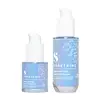What's inside
What's inside
 Key Ingredients
Key Ingredients

 Benefits
Benefits

 Concerns
Concerns

No concerns
 Ingredients Side-by-side
Ingredients Side-by-side

Water
Skin ConditioningAmmonium Polyacryloyldimethyl Taurate
Emulsion StabilisingButylene Glycol
HumectantHydrogenated Lecithin
EmulsifyingPotassium Methoxysalicylate
BleachingPhenoxyethanol
PreservativeDipentaerythrityl Hexa C5-9 Acid Esters
Skin ConditioningNeopentyl Glycol Diheptanoate
EmollientPolymethylsilsesquioxane
Polyglyceryl-4 Caprate
EmulsifyingAroma
Benzotriazolyl Dodecyl P-Cresol
UV AbsorberBHT
AntioxidantDisodium EDTA
Ethylhexylglycerin
Skin ConditioningMalus Domestica Fruit Cell Culture Extract
Skin ConditioningXanthan Gum
EmulsifyingGlycerin
HumectantCaprylyl Glycol
EmollientLecithin
EmollientDiamond Powder
AbrasiveGlyceryl Caprylate
EmollientLactic Acid/Glycolic Acid Copolymer
Skin ConditioningPhenylpropanol
MaskingChlorella Vulgaris Extract
Skin ConditioningPolyvinyl Alcohol
Heptapeptide-15 Palmitate
Skin ConditioningWater, Ammonium Polyacryloyldimethyl Taurate, Butylene Glycol, Hydrogenated Lecithin, Potassium Methoxysalicylate, Phenoxyethanol, Dipentaerythrityl Hexa C5-9 Acid Esters, Neopentyl Glycol Diheptanoate, Polymethylsilsesquioxane, Polyglyceryl-4 Caprate, Aroma, Benzotriazolyl Dodecyl P-Cresol, BHT, Disodium EDTA, Ethylhexylglycerin, Malus Domestica Fruit Cell Culture Extract, Xanthan Gum, Glycerin, Caprylyl Glycol, Lecithin, Diamond Powder, Glyceryl Caprylate, Lactic Acid/Glycolic Acid Copolymer, Phenylpropanol, Chlorella Vulgaris Extract, Polyvinyl Alcohol, Heptapeptide-15 Palmitate
Water
Skin ConditioningButylene Glycol
HumectantSqualane
EmollientNeopentyl Glycol Diheptanoate
EmollientPentylene Glycol
Skin ConditioningDipentaerythrityl Hexa C5-9 Acid Esters
Skin ConditioningBetaine
HumectantPolyglycerin-3
HumectantEthylhexyl Methoxycinnamate
UV Absorber1,2-Hexanediol
Skin ConditioningCetyl Ethylhexanoate
EmollientHydrogenated Olive Oil Unsaponifiables
Emollient4-T-Butylcyclohexanol
MaskingAllantoin
Skin ConditioningPoloxamer 235
EmulsifyingAcrylates/C10-30 Alkyl Acrylate Crosspolymer
Emulsion StabilisingHydrogenated Lecithin
EmulsifyingXanthan Gum
EmulsifyingRetinol
Skin ConditioningSodium Dilauramidoglutamide Lysine
HumectantPolysorbate 20
EmulsifyingSodium Ascorbate
AntioxidantSodium Phytate
Ethylhexylglycerin
Skin ConditioningEpigallocatechin Gallate
AntioxidantBHT
AntioxidantDisodium EDTA
Phenoxyethanol
PreservativeBHA
AntioxidantTocopherol
AntioxidantWater, Butylene Glycol, Squalane, Neopentyl Glycol Diheptanoate, Pentylene Glycol, Dipentaerythrityl Hexa C5-9 Acid Esters, Betaine, Polyglycerin-3, Ethylhexyl Methoxycinnamate, 1,2-Hexanediol, Cetyl Ethylhexanoate, Hydrogenated Olive Oil Unsaponifiables, 4-T-Butylcyclohexanol, Allantoin, Poloxamer 235, Acrylates/C10-30 Alkyl Acrylate Crosspolymer, Hydrogenated Lecithin, Xanthan Gum, Retinol, Sodium Dilauramidoglutamide Lysine, Polysorbate 20, Sodium Ascorbate, Sodium Phytate, Ethylhexylglycerin, Epigallocatechin Gallate, BHT, Disodium EDTA, Phenoxyethanol, BHA, Tocopherol
 Reviews
Reviews

Ingredients Explained
These ingredients are found in both products.
Ingredients higher up in an ingredient list are typically present in a larger amount.
BHT is a synthetic antioxidant and preservative.
As an antioxidant, it helps your body fight off free-radicals. Free-radicals are molecules that may damage your skin cells.
As a preservative, it is used to stabilize products and prevent them from degrading. Specifically, BHT prevents degradation from oxidation.
The concerns related to BHT come from oral studies; this ingredient is currently allowed for use by both the FDA and EU.
However, it was recently restricted for use in the UK as of April 2024.
Learn more about BHTButylene Glycol (or BG) is used within cosmetic products for a few different reasons:
Overall, Butylene Glycol is a safe and well-rounded ingredient that works well with other ingredients.
Though this ingredient works well with most skin types, some people with sensitive skin may experience a reaction such as allergic rashes, closed comedones, or itchiness.
Learn more about Butylene GlycolWe don't have a description for Dipentaerythrityl Hexa C5-9 Acid Esters yet.
Disodium EDTA plays a role in making products more stable by aiding other preservatives.
It is a chelating agent, meaning it neutralizes metal ions that may be found in a product.
Disodium EDTA is a salt of edetic acid and is found to be safe in cosmetic ingredients.
Learn more about Disodium EDTAEthylhexylglycerin (we can't pronounce this either) is commonly used as a preservative and skin softener. It is derived from glyceryl.
You might see Ethylhexylglycerin often paired with other preservatives such as phenoxyethanol. Ethylhexylglycerin has been found to increase the effectiveness of these other preservatives.
Hydrogenated Lecithin is created from the hydrogenation of lecithin (a group of phospholipids). Hydrogenation is a chemical reaction between hydrogen and another element.
This ingredient is an emollient and emulsifier. As an emollient, it helps soften skin by trapping moisture within. As an emulsifier, it prevents oil and water ingredients from separating.
We don't have a description for Neopentyl Glycol Diheptanoate yet.
Phenoxyethanol is a preservative that has germicide, antimicrobial, and aromatic properties. Studies show that phenoxyethanol can prevent microbial growth. By itself, it has a scent that is similar to that of a rose.
It's often used in formulations along with Caprylyl Glycol to preserve the shelf life of products.
Water. It's the most common cosmetic ingredient of all. You'll usually see it at the top of ingredient lists, meaning that it makes up the largest part of the product.
So why is it so popular? Water most often acts as a solvent - this means that it helps dissolve other ingredients into the formulation.
You'll also recognize water as that liquid we all need to stay alive. If you see this, drink a glass of water. Stay hydrated!
Learn more about WaterXanthan gum is used as a stabilizer and thickener within cosmetic products. It helps give products a sticky, thick feeling - preventing them from being too runny.
On the technical side of things, xanthan gum is a polysaccharide - a combination consisting of multiple sugar molecules bonded together.
Xanthan gum is a pretty common and great ingredient. It is a natural, non-toxic, non-irritating ingredient that is also commonly used in food products.
Learn more about Xanthan Gum